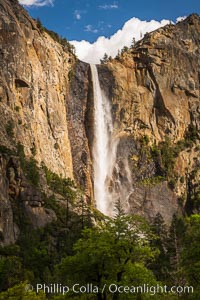
Bridalveil Falls at sunset, with clouds and blue sky in the background. Bridalveil Falls in Yosemite drops 620 feet (188 m) from a hanging valley to the floor of Yosemite Valley.
Location: Bridalveil Falls, Yosemite National Park, California
Image ID: 34540
Location: Bridalveil Falls, Yosemite National Park, California
Image ID: 34540
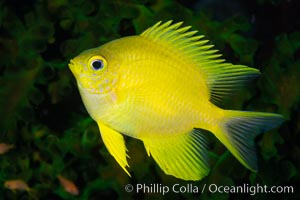
Golden Damselfish, Fiji.
Species: Golden damselfish, Amblyglyphidodon aureus
Location: Fiji
Image ID: 34809
Species: Golden damselfish, Amblyglyphidodon aureus
Location: Fiji
Image ID: 34809
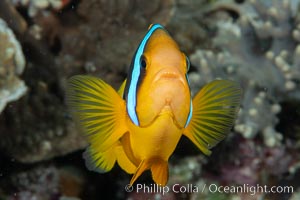
Bluestripe clownfish, Amphiprion chrysopterus, Fiji.
Species: Bluestripe clownfish, Amphiprion chrysopterus
Location: Fiji
Image ID: 34826
Species: Bluestripe clownfish, Amphiprion chrysopterus
Location: Fiji
Image ID: 34826
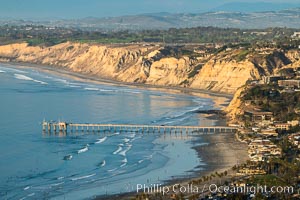
La Jolla Shores Coastline and Scripps Pier, Blacks Beach and Torrey Pines Golf Course and State Reserve, aerial photo, sunset. The Gold Coast of La Jolla basks in the warm waning light of a winter afternoon.
Location: La Jolla, California
Image ID: 36669
Location: La Jolla, California
Image ID: 36669
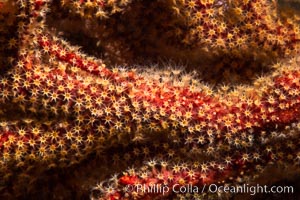
California Golden gorgonian polyps. The golden gorgonian is a colonial organism composed of thousands of tiny polyps. Each polyp secretes calcium which accumulates to form the structure of the colony. The fan-shaped gorgonian is oriented perpendicular to prevailing ocean currents to better enable to filter-feeding polyps to capture passing plankton and detritus passing by.
Location: San Diego, California
Image ID: 37204
Location: San Diego, California
Image ID: 37204
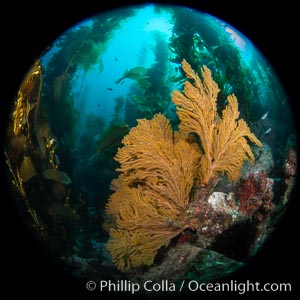
Golden gorgonian on underwater rocky reef, amid kelp forest, Catalina Island.
Species: California golden gorgonian, Muricea californica
Location: Catalina Island, California
Image ID: 37256
Species: California golden gorgonian, Muricea californica
Location: Catalina Island, California
Image ID: 37256
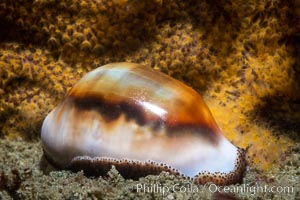
Chestnut cowrie with mantle withdrawn, in front of golden gorgonian.
Species: Chestnut Cowrie, Date Cowrie, Cypraea spadicea
Location: San Diego, California
Image ID: 37289
Species: Chestnut Cowrie, Date Cowrie, Cypraea spadicea
Location: San Diego, California
Image ID: 37289
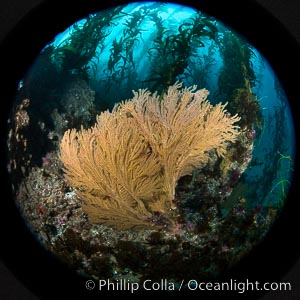
Garibaldi and California golden gorgonian on underwater rocky reef, San Clemente Island. The golden gorgonian is a filter-feeding temperate colonial species that lives on the rocky bottom at depths between 50 to 200 feet deep. Each individual polyp is a distinct animal, together they secrete calcium that forms the structure of the colony. Gorgonians are oriented at right angles to prevailing water currents to capture plankton drifting by.
Species: California golden gorgonian, Giant kelp, Muricea californica, Macrocystis pyrifera
Location: San Clemente Island, California
Image ID: 38501
Species: California golden gorgonian, Giant kelp, Muricea californica, Macrocystis pyrifera
Location: San Clemente Island, California
Image ID: 38501
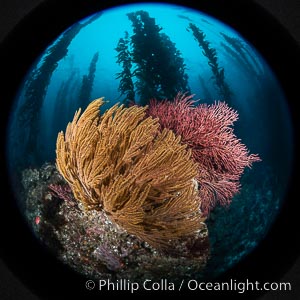
Garibaldi and California golden gorgonian on underwater rocky reef, San Clemente Island. The golden gorgonian is a filter-feeding temperate colonial species that lives on the rocky bottom at depths between 50 to 200 feet deep. Each individual polyp is a distinct animal, together they secrete calcium that forms the structure of the colony. Gorgonians are oriented at right angles to prevailing water currents to capture plankton drifting by.
Species: California golden gorgonian, Giant kelp, Muricea californica, Macrocystis pyrifera
Location: San Clemente Island, California
Image ID: 38504
Species: California golden gorgonian, Giant kelp, Muricea californica, Macrocystis pyrifera
Location: San Clemente Island, California
Image ID: 38504
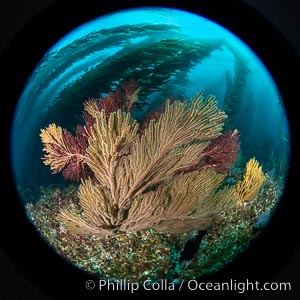
Garibaldi and California golden gorgonian on underwater rocky reef, San Clemente Island. The golden gorgonian is a filter-feeding temperate colonial species that lives on the rocky bottom at depths between 50 to 200 feet deep. Each individual polyp is a distinct animal, together they secrete calcium that forms the structure of the colony. Gorgonians are oriented at right angles to prevailing water currents to capture plankton drifting by.
Species: California golden gorgonian, Giant kelp, Muricea californica, Macrocystis pyrifera
Location: San Clemente Island, California
Image ID: 38509
Species: California golden gorgonian, Giant kelp, Muricea californica, Macrocystis pyrifera
Location: San Clemente Island, California
Image ID: 38509
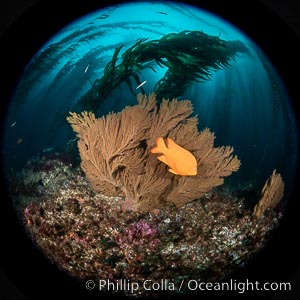
Garibaldi and California golden gorgonian on underwater rocky reef, San Clemente Island. The golden gorgonian is a filter-feeding temperate colonial species that lives on the rocky bottom at depths between 50 to 200 feet deep. Each individual polyp is a distinct animal, together they secrete calcium that forms the structure of the colony. Gorgonians are oriented at right angles to prevailing water currents to capture plankton drifting by.
Species: California golden gorgonian, Giant kelp, Garibaldi, Muricea californica, Macrocystis pyrifera, Hypsypops rubicundus
Location: San Clemente Island, California
Image ID: 38510
Species: California golden gorgonian, Giant kelp, Garibaldi, Muricea californica, Macrocystis pyrifera, Hypsypops rubicundus
Location: San Clemente Island, California
Image ID: 38510
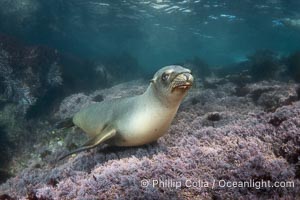
A beautiful golden-brown female California Sea Lion at the Coronado Islands, posing on a carpet of purple marine algae, Baja California, Mexico.
Species: California sea lion, Zalophus californianus
Location: Coronado Islands (Islas Coronado), Baja California, Mexico
Image ID: 38566
Species: California sea lion, Zalophus californianus
Location: Coronado Islands (Islas Coronado), Baja California, Mexico
Image ID: 38566
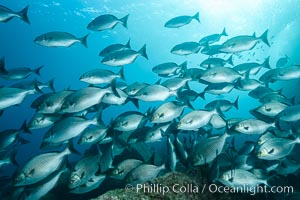
Blue-bronze sea chub schooling, Sea of Cortez.
Species: Blue-bronze chub, Kyphosus analogus
Location: Sea of Cortez, Baja California, Mexico
Image ID: 31230
Species: Blue-bronze chub, Kyphosus analogus
Location: Sea of Cortez, Baja California, Mexico
Image ID: 31230
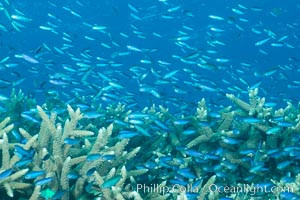
Juvenile blue-green chromis schooling in ocean current over hard corals, Fijii.
Species: Blue-green chromis, Chromis viridis
Location: Makogai Island, Lomaiviti Archipelago, Fiji
Image ID: 31398
Species: Blue-green chromis, Chromis viridis
Location: Makogai Island, Lomaiviti Archipelago, Fiji
Image ID: 31398
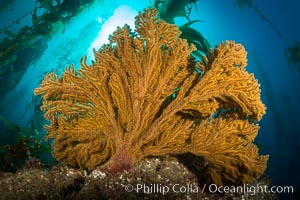
Golden gorgonian on underwater rocky reef, amid kelp forest, Catalina Island. The golden gorgonian is a filter-feeding temperate colonial species that lives on the rocky bottom at depths between 50 to 200 feet deep. Each individual polyp is a distinct animal, together they secrete calcium that forms the structure of the colony. Gorgonians are oriented at right angles to prevailing water currents to capture plankton drifting by.
Species: California golden gorgonian, Muricea californica
Location: Catalina Island, California
Image ID: 34219
Species: California golden gorgonian, Muricea californica
Location: Catalina Island, California
Image ID: 34219
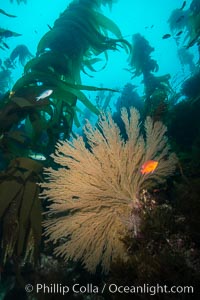
Garibaldi and California golden gorgonian on underwater rocky reef, San Clemente Island. The golden gorgonian is a filter-feeding temperate colonial species that lives on the rocky bottom at depths between 50 to 200 feet deep. Each individual polyp is a distinct animal, together they secrete calcium that forms the structure of the colony. Gorgonians are oriented at right angles to prevailing water currents to capture plankton drifting by.
Species: California golden gorgonian, Garibaldi, Hypsypops rubicundus, Muricea californica
Location: San Clemente Island, California
Image ID: 30864
Species: California golden gorgonian, Garibaldi, Hypsypops rubicundus, Muricea californica
Location: San Clemente Island, California
Image ID: 30864
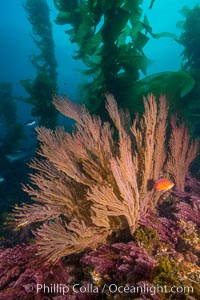
California golden gorgonian on underwater rocky reef below kelp forest, San Clemente Island. The golden gorgonian is a filter-feeding temperate colonial species that lives on the rocky bottom at depths between 50 to 200 feet deep. Each individual polyp is a distinct animal, together they secrete calcium that forms the structure of the colony. Gorgonians are oriented at right angles to prevailing water currents to capture plankton drifting by, San Clemente Island.
Species: California golden gorgonian, Muricea californica
Location: San Clemente Island, California
Image ID: 30909
Species: California golden gorgonian, Muricea californica
Location: San Clemente Island, California
Image ID: 30909
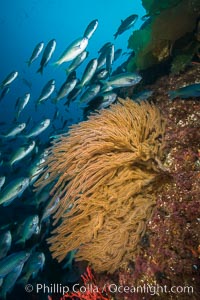
Blacksmith Chromis and California golden gorgonian on underwater rocky reef, San Clemente Island. The golden gorgonian is a filter-feeding temperate colonial species that lives on the rocky bottom at depths between 50 to 200 feet deep. Each individual polyp is a distinct animal, together they secrete calcium that forms the structure of the colony. Gorgonians are oriented at right angles to prevailing water currents to capture plankton drifting by.
Species: Blacksmith, California golden gorgonian, Chromis punctipinnis, Muricea californica
Location: San Clemente Island, California
Image ID: 30956
Species: Blacksmith, California golden gorgonian, Chromis punctipinnis, Muricea californica
Location: San Clemente Island, California
Image ID: 30956
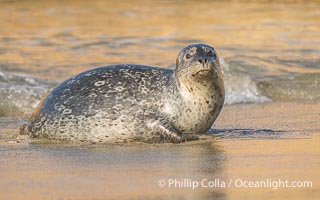
Chonky Pacific harbor seal on wet gold-colored sandy beach in La Jolla.
Location: La Jolla, California
Image ID: 39833
Location: La Jolla, California
Image ID: 39833
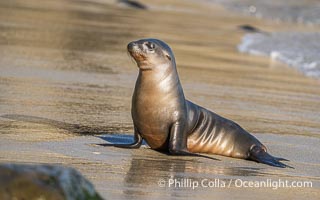
California Sea Lion on Golden Sand Beach La Jolla Cove, San Diego.
Species: California sea lion, Zalophus californianus
Location: La Jolla, California
Image ID: 39852
Species: California sea lion, Zalophus californianus
Location: La Jolla, California
Image ID: 39852
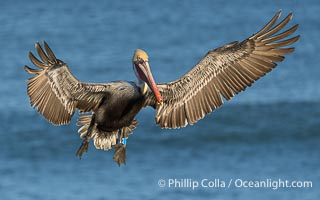
Brown Pelican with Identification Tags on Legs, blue on left leg and metal alloy on right leg. These tags aid scientists in understanding how the birds travel and recover if they have been rehabilitated.
Species: Brown Pelican, Pelecanus occidentalis californicus, Pelecanus occidentalis
Image ID: 39885
Species: Brown Pelican, Pelecanus occidentalis californicus, Pelecanus occidentalis
Image ID: 39885
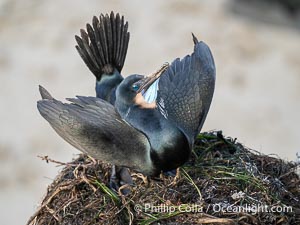
Male Brandt's Cormorant Skypointing, Courtship Display, Breeding Plumage with blue throat and a few white pin-feathers, La Jolla. Skypointing is an interesting courtship behavior that many birds practice. Among Brandt's Cormorants the male performs this, likely as a way of attracting a mate to the nest he has built by showing off his striking blue throat. He tips his head backward showing off his striking blue throat, and partially raises his wings. Seen here on seacliffs above the ocean.
Species: Brandt's cormorant, Phalacrocorax penicillatus
Location: La Jolla, California
Image ID: 40133
Species: Brandt's cormorant, Phalacrocorax penicillatus
Location: La Jolla, California
Image ID: 40133
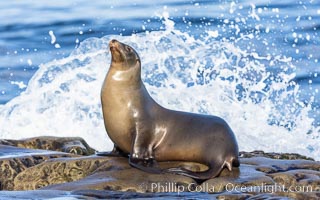
Beautiful golden-brown adult female California Sea Lion, resting on rocks in the morning sun, La Jolla, catching a little splash from a wave breaking on the reef just behind her.
Species: California Sea Lion, Zalophus californianus
Location: La Jolla, California
Image ID: 37528
Species: California Sea Lion, Zalophus californianus
Location: La Jolla, California
Image ID: 37528
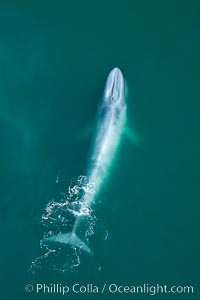
Blue whale swims at the surface of the ocean in this aerial photograph. The blue whale is the largest animal ever to have lived on Earth, exceeding 100' in length and 200 tons in weight.
Species: Blue whale, Balaenoptera musculus
Location: Redondo Beach, California
Image ID: 25952
Species: Blue whale, Balaenoptera musculus
Location: Redondo Beach, California
Image ID: 25952
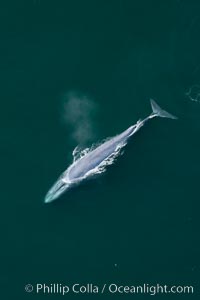
Blue whale, exhaling as it surfaces from a dive, aerial photo. The blue whale is the largest animal ever to have lived on Earth, exceeding 100' in length and 200 tons in weight.
Species: Blue whale, Balaenoptera musculus
Location: Redondo Beach, California
Image ID: 25956
Species: Blue whale, Balaenoptera musculus
Location: Redondo Beach, California
Image ID: 25956
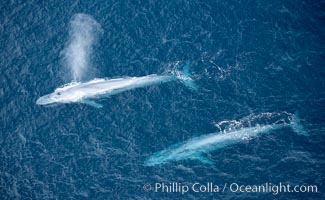
Blue whale, exhaling in a huge blow as it swims at the surface between deep dives. The blue whale's blow is a combination of water spray from around its blowhole and condensation from its warm breath.
Species: Blue whale, Balaenoptera musculus
Location: La Jolla, California
Image ID: 21254
Species: Blue whale, Balaenoptera musculus
Location: La Jolla, California
Image ID: 21254
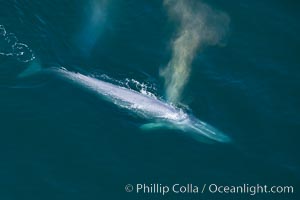
Blue whale, exhaling as it surfaces from a dive, aerial photo. The blue whale is the largest animal ever to have lived on Earth, exceeding 100' in length and 200 tons in weight.
Species: Blue whale, Balaenoptera musculus
Location: Redondo Beach, California
Image ID: 25954
Species: Blue whale, Balaenoptera musculus
Location: Redondo Beach, California
Image ID: 25954
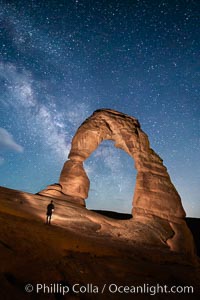
Delicate Arch and Milky Way, lit by quarter moon, hiker's flashlight and the fading blue sky one hour after sunset. Arches National Park, Utah.
Location: Arches National Park, Utah
Image ID: 27855
Location: Arches National Park, Utah
Image ID: 27855
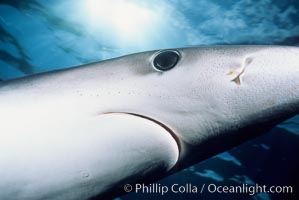
Blue shark showing ampullae of Lorenzini, eye and small portion of nictitating membrane.
Species: Blue shark, Prionace glauca
Location: San Diego, California
Image ID: 01076
Species: Blue shark, Prionace glauca
Location: San Diego, California
Image ID: 01076
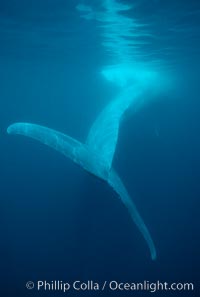
Blue whale fluke, powerful tail that propels the huge whale through the open ocean.
Species: Blue whale, Balaenoptera musculus
Image ID: 01910
Species: Blue whale, Balaenoptera musculus
Image ID: 01910